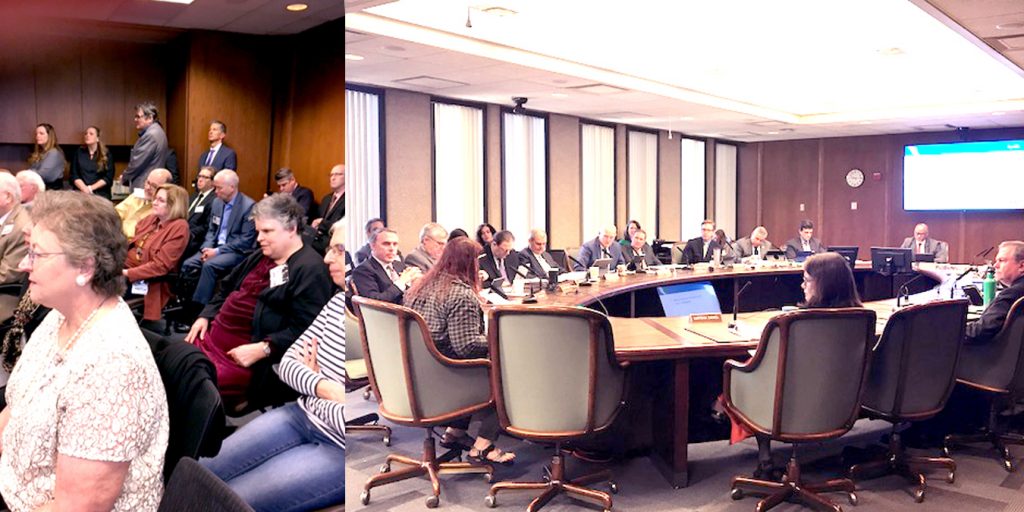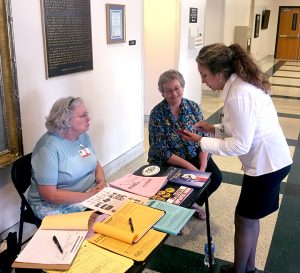
Due to the overwhelming amount of communication received from TSEU members, the TRS Board of Trustees has once again postponed their vote to lower the rate of return until their next meeting in July. TSEU members began organizing last fall to oppose the unnecessary devaluation of their TRS pension fund by sending emails, collecting petition signatures, and testifying at Board of Trustees meetings. As a result, the TRS Board of Trustees has twice postponed the vote to adopt the recommendations made by an experience study (conducted 3 years prematurely) to lower the expected rate of return from 8% to 7.25%.
Seven TSEU members attended the April 20th TRS Board meeting to address the board and provide member comment, four of whom are actively paying into TRS: Lauren Goodley (TSU-San Marcos), Anne Lewis, Michael Schmidt (UT Austin), Angie Lopez (UTHSC- San Antonio) as well as 3 ROC activists: Judy Holloway, Angie Khan, and Thomas Kreneck who are currently relying on the continued solvency of their TRS pensions. Occupying the entire first hour of the meeting, they urged the board members to protect their pensions and reject any recommendations made to degrade the health of the fund.
DID YOU KNOW: TRS is among the highest-performing defined benefits pension funds in the country and has consistently outperformed all anticipated returns. There has been a growing trend over the past 30 years to diminish and/or eliminate defined-benefit pension plans. It is up to us to protect these plans from being slowly devalued until they are so underfunded they can easily be turned into 401(k)-style defined contribution (DC) plans.
Defined benefit plans vs. defined contribution plans
Defined benefit plans (like those of ERS and TRS) guarantee a basic income to workers for as long as they live. Unlike DC plans that only pay for as long as there’s money in the account, retirees with DB plans can never outlive their pensions. DC plans are a bad deal for workers because they shift the entire burden and risk of saving for retirement away from the employer and onto the individual employee. They also line the pockets of Wall Street because they come with high fees for handling so many individual retirement accounts. This makes them a bad deal for taxpayers, as well as employees. In the last few legislative sessions, TSEU members have fought hard to defeat several bills intended to convert ERS and TRS into risky, 401k-like, DC plans.
So, what is the “rate of return” and why is it so important?
The rate of return is used to reflect the expected health of the pension fund – particularly if it will have enough funds to provide promised benefits to retirees. The formula used to determine this status depends on employment, retirement, mortality, and stock market trends and projections for a 30 year period.
State law requires TRS’ actuaries to conduct such an “experience study” only once every 5 years – to determine how much is needed in contributions to keep the fund solvent. The last study made in 2015 indicated that an 8% rate of return was reasonable and according to the 2017 report, TRS achieved well over 12% in returns. Despite this, the 2017 study recommends lowering the rate of return to 7.25%. The Board of Trustees has argued that a lowered rate of return will incentivize the state legislature to increase state contributions to the fund. However, there is no historical evidence of the state having ever contributed more towards a lower-performing fund.
Such a drastic decline in the TRS expected rate of return will instead make the fund suddenly appear in much worse financial health than is true. In fact, it would bolster the claims of anti-pension groups that funds like TRS are heading for bankruptcy. Anti-pension groups like the John and Laura Arnold Foundation hope to push lawmakers to abandon traditional pensions like TRS in favor of DC plans. On top of making TRS appear unhealthy, lowering the expected rate of return also has the immediate effect of making it harder for TRS to provide a long overdue cost of living increase for current retirees.
What’s next?
While it is a tremendous feat to have stalled the TRS Board vote, very soon the Board will meet again on whether or not to accept the recommendations of this politically-timed study and lower the assumed rate of return below 8%. If they vote to lower it, the health and sustainability of our pension will take a huge step backward, and the possibility of losing our defined benefit pension plans will increase. If you would like to join other TSEU members in addressing the TRS Board of Trustees at the July 26-27 meeting in Austin, please contact Taylor Jones at 512-448-4225 or tjones@cwa-tseu.org. Your voice and presence is very much needed.
 KEEP THE PRESSURE ON! What to do now:
KEEP THE PRESSURE ON! What to do now:
-
Join TSEU or sign up a new member! CLICK HERE
-
Sign and share the online petition: CLICK HERE
-
Send an email TODAY to the TRS Board: trscomments@trs.texas.gov
Urge them to protect our pensions by rejecting any recommendation made by the 2017 experience study to lower TRS’ assumed rate of return. TRS is currently the healthiest pension fund in the country and has consistently out-performed all expected returns. Tell them there’s no reason to make this change – it will only hurt current and future retirees.